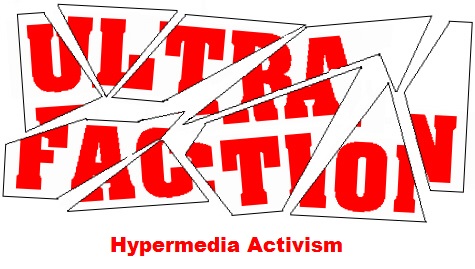

|
|
This picture depicts a spacial outlook of what an ideological grid or map would look like during information navigation. According to John Underkoffler, three dimensional navigation/manipulation is the future and much that isn't spacial inherently can be depicted spacially. |
A FEW PROBLEMS WITH TODAY'S SUBJECT OF MASS INFORMATION HANDLING:
(1) Blogging results in countless tangents and quickly devolves into a tangled mess in just a few posts.
(2) The website Politicalinformation.com stated that they find the 567th link they wanted when doing a search for a topic.
(3) When dealing with scores of links from a web search or a list on a web site, after 10 you get tired and lost.
(4) You can't do an Internet search for a theme on a search engine such as "conservative claiming political correctness getting out of hand" because an article that cites such a concept may not use any of those words.
(5) You can not look at a single glance at an electronic map of a search engine and actually see certain events or notions such as "JFK Democrats set political climate for nineties environmentalists" in the same way that you can see a spike in a chart, or a bell curve when viewing statistics.
Opinion tags (which may be also called "online bookmarks") used by search engines.
When using this new search engine you can associate the label "conservatives seeing political correctness getting out of hand" with the URL. Hopefully as the technology on the web evolves, the information would be integrated into the document itself. For other documents that are not authored by the tagger, there can be a button on the website (or on the browser) just like on any typical blogger boards such as quote and reply, and this button can be to embed these opinion tags into the beginning of the text, to be revealed if a certain button is clicked. One obvious problem with a system like this is that there may be a few gigs of tags for a 100K file. This is simply the wave of a truly futuristic system and can not be avoided.
The goal here is to organize information by theme and statistics instead of words.
This may have the same affect that graphing calculators have had in calculus classes. Once a college teacher explained that much time was wasted in graphing on paper, and now the class can focus on changing the graphs at critical points in an instant, as opposed to having to manually draw the graph point by point. Under this new system, a reader can see theme and elements behind the information, which is the real goal to begin with. Raw stats are simply a tool in trying to get a point across, as well as essays and speeches. The theme is what matters, so if a system was perfected that would reflect theme at a glance, much more information would be able to be conveyed at a faster pace.
THE TUTORIAL(PHASE ONE:CALIBRATION)
To navigate through this database, there could be many possible starting points. One point would be a CALIBRATION MENU. This would ask you from anywhere from 10 to 500 questions on socio-political topics to see how you think and with whom/what you disagree or agree.
Which are you?
| CONSERVATIVE | LIBERAL | OTHER |
Let's say the user chooses "CONSERVATIVE":
And now they can choose as how to define their version of "CONSERVATIVE":
Do you want to define your politics by people, issue or groups? (or two or all of the categories?)
| PERSON | ISSUE | GROUP |
Let's say they choose ALL of "PERSON AND GROUP AND ISSUE" and the following menus would pop up:
ISSUE (select all of these that apply to you)
| ABORTION:
I am pro-life |
GUN
CONTROL:
I believe in no gun control |
TAXES:
I believe in lower taxes or repeal income tax |
CONDOMS IN
HIGH
SCHOOLS:
I am against it |
PORN:
I am for community standards in porn |
PERSON (Select the people that you agree with in some fashion)
| Rush Limbaugh | Sean Hannity | Michelle Maulkin | Pat Buchanan | Pat Robertson |
| Alan Keyes | Dr. Laura | Ralph Reed | Bob Dornan | Steve Forbes |
GROUP (Select groups that you identify with)
| NRA | CWFA | Citizens against government waste | Christian Coalition |
This would be a yes or no, (or as in computers a 1 or 0). Then the degrees would start to set in:
Subsets to those categories
Please rate these choice of your to a degree from 1 to 10
Abortion: (PRO LIFE)
| Level 1 | Only partial birth abortion is forbidden |
| Level 2 | Partial birth and third trimester forbidden |
| Level 3 | (something here) |
| Level 4 | Forbidden after nervous system of baby is formed |
| Level 5 | (something here) |
| Level 6 | (something here) |
| Level 7 | Incest, rape, life of mother |
| Level 8 | Rape, life of mother |
| Level 9 | Life of the mother |
| Level 10 | No abortion under any circumstances |
The same chart can apply for all other issues:
Rush Limbaugh (chosen as option of agreement)
| Level 1 | I agree with a small bit of what he says |
| Level 2 | I agree with a decent amount of what he says |
| Level 3 | I agree with about half of what he says |
| Level 4 | I agree with most of what he says |
| Level 5 | I agree with all or nearly everything he says |
Or even a database of 10,100 or 1000 statements he has made that you can click YES, SOME or NO of how much you agree with him to polish off your preferences.
Also, we can have perhaps a list of every law passed in the last 50 years and you can click if you agree with it or not to help you navigate a legal database, or a list of all court cases in the last 50 years for a judicial database.
THE TUTORIAL(PHASE TWO:MAP PLOTTING)
After this, the software can present you with the top 5, 10 or 100 ideological "maps" that may best suit your information browsing and navigation (thus you taking the name of a new political "format").
For example, take the ten socio-political issues:
rap
safer sex
anger at the past
political correctness
military
globalism
exclusive god
free market
alienation
Rush Limbaugh
...and lay them out over a six leveled grid of acceptability in the context of three "formats":
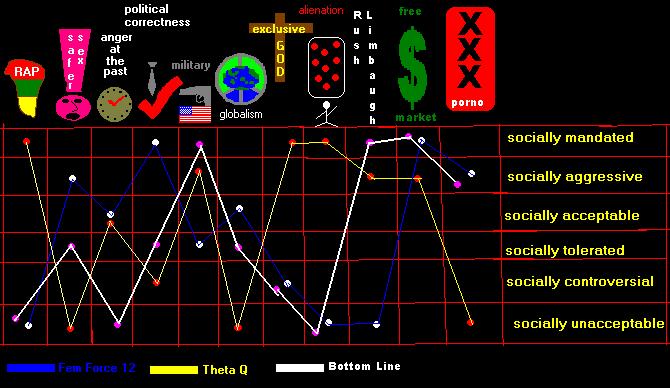
Here, you are saying that these ten items are significant in determining the socio-political views of someone to be fitted into a "format".
The "extreme 19" map (used by 759,872 users) defines you as 98% of the "fem force 12" format, 57% of the "bottom line" format and 28% of the "theta q" format.
You can also pick from a giant list of terms to build your own grid, as opposed to being plotted on a previously configured one.
| innovationist | executer | reformer | revelationist | depicter | reaffirmationist | initiator |
| organizer | spear header | absorber | traditionalist | activist | revolutionary | non-conformist |
| evaluationist | assesor | scrutinizationist | trend setter | conformist | instigator | visionary |
| rebel | catalyst | assistant | post structuralist | coercer | influencer | refiner |
| tactitionist | conveyor | enforcer | enhancer | dissectionist | analyzer | conclusionist |
You can give each of the picked terms a level of importance as to how it is used to describe your political format. It can be arranged in a pyramid like this:
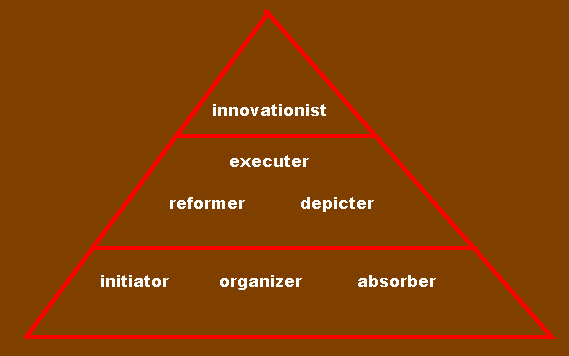
All of the items following the "level one" term(s) are defined BUT strictly in the context of the higher level terms. In this example, you would be an innovationist primarily BUT you would be an executing, reformer, depicter innovationist. You would be basically saying that the "executing reformer depicter" elements would be a mere SUBSET to your innovationism, as which may be better depicted here:
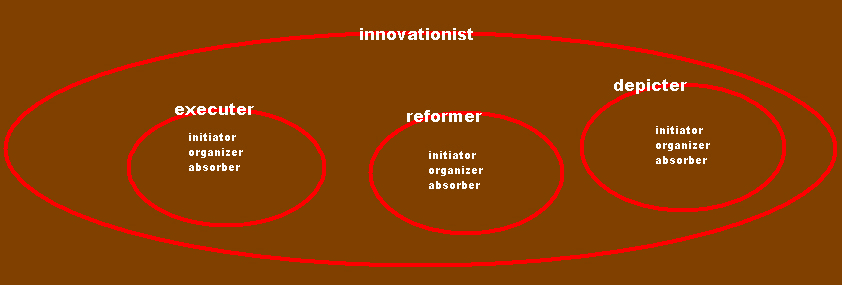
Then you can say with this configuration that you can be an executer only in the context of being an innovationist FIRST, then you can be an initiator but ONLY in the context of being an executer FIRST. This is taking certain subsets out of certain "zones" (being the definition of socio-political terms).
Another way of saying this:
As with the bubble (with subsets) above, you can see that you would be saying that you are primarily an INNOVATIONIST but you only want the three elements out of "innovationist" that are executer, reformer and depicter. For example, this would exclude "innovationist maintainer" on the grounds that you feel being called a "maintainer" on any level would be inconsistent with "executer, reformer, depicter".
The purpose to all of this is to fine tune a search algorythym. Let's do this with an obvious political term search scenario:
Let's say that depending on which era in which we are, that feeling alienated can happen to any political faction. Usually, it happens to the faction NOT in power. The faction in power might feel that they are not getting enough done, or that they don't have ENOUGH power and feel alienated as well. So let's say that you want to do a search for all sites or articles that have a tone or instance of being a liberal Democrat but with alienation:
You start off with the entire database segmented according to the main two political parties:
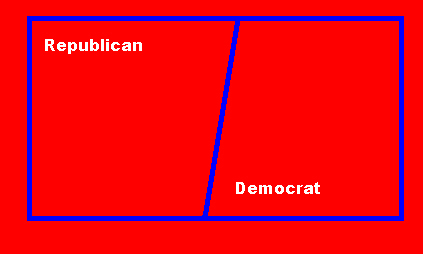
Then you search for a subset, like Richard Gephardt:
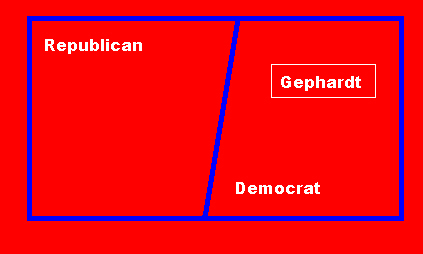
Then here comes a tricky part. You want to do a universal search for all instances of alienation regardless of them falling into your subset but with a TILT to your subset, so you may do a descending priority pyramid or chart of some sort. (The circled "A" is for alienation).
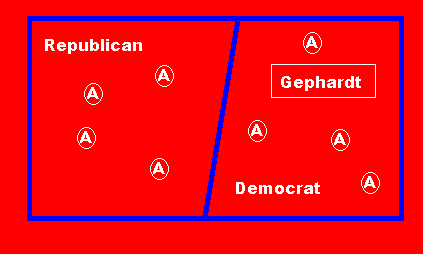
Then you can lay the results out on a priority pyramid here:
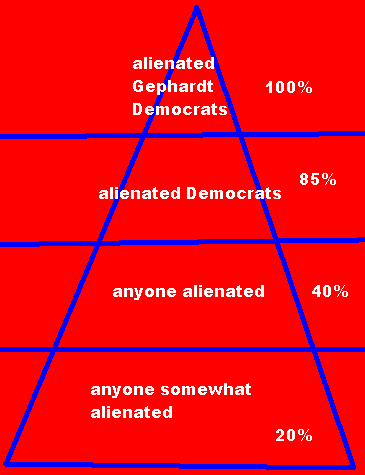
The goal here is to be inclusive but at the same time lay out a realistic probability of a match of content to the searcher's mindset.
There may come a time when the user gets more comfortable with the software that they want to build their own grid. There may be various reasons for this. One reason is that the user may not be satisifed with the conventional scales of the website and feels that they have to "henpeck" pieces all over the grid instead of having one concentrated subset.
For example, look at this previously depicted "scatterplot" chart labeling the element alienation:

Here, the element of alienation is "scatterplotted" over the grid because (in this example) the users on a conglomerate level, cited that alienation is something that can be found on both sides, and in different factions as well. Let's say that a liberal user feels that a major component of liberalism is alienation, and feels that this conglomerate chart is not realistic. The user will then engage in an effort to build a map that relfects that alienation is a liberal element. The user will build a map like this:
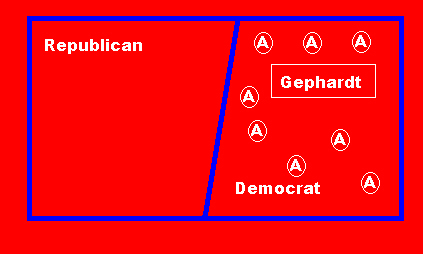
This can be done by calling up a menu and assigning a level one priority to the term "alienation" and defining your format as liberal. Also, other users that have the term "alienation" in their formats may be categorized more so as liberal instead of moderate or conservative. The user has just defined their own grid!
Sometimes you want to say two things in the same sentence.
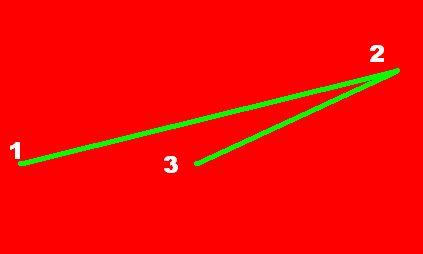
Here you are trying to have two scales on one line. In one context, you are saying that "2" is more than "3", since it is furhter to the right, but if you follow the length of the line, "3" is clearly further to the right of "2".
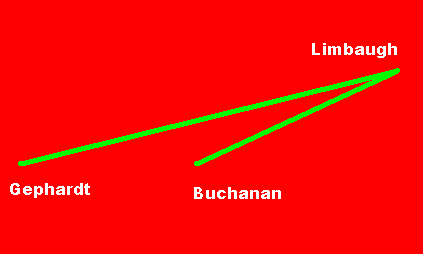
In this picture above, one can argue that Rush Limbaugh is more to the right of Pat Buchanan in the context of being effective, and arguing that he is more entrenched, so in that specific context, you can argue that Limbaugh is more significant that Buchanan. In a practical context, you can argue that Buchanan is more to the right wing and belongs at the end of the line in the picture above.
To add another line:
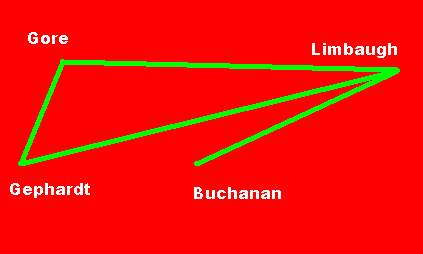
This would say that there is another scale with Limbaugh at the end, which ignores Buchanan and put Al Gore somwhere to the generic left wing. The point can be an axis of being more recognized or established.
And to add yet another line:
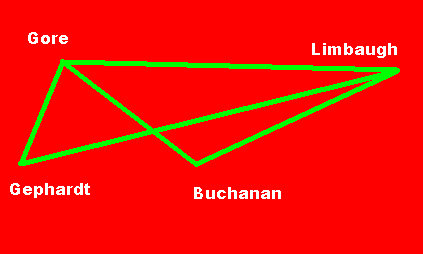
Here can be an example of putting Gore to the far left and Buchanan to the far right. This can be trying to say many different things in the same picture.
...as well as a few other arbitrary "shatterbox" grids:
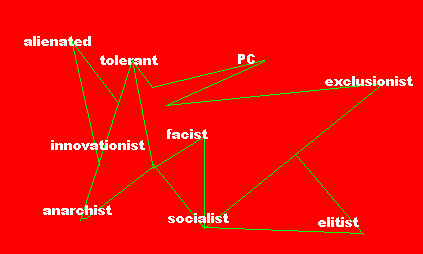
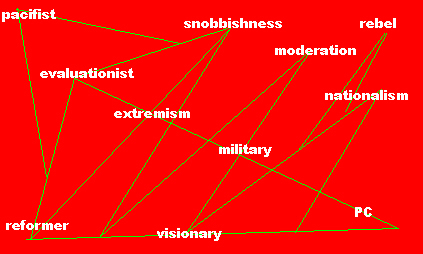
You can also use entire grids as a mere point on another grid to attempt to integrate multiple grids.
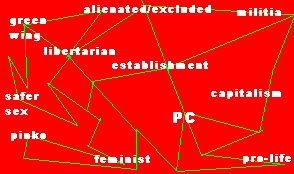
The "where are you map" (used by 219,478 users) defines you as a "pro-establishment capitalist Politically Correct Libertarian"
This is the EXACT opposite of an anti-establishment socialist politically incorrect populist
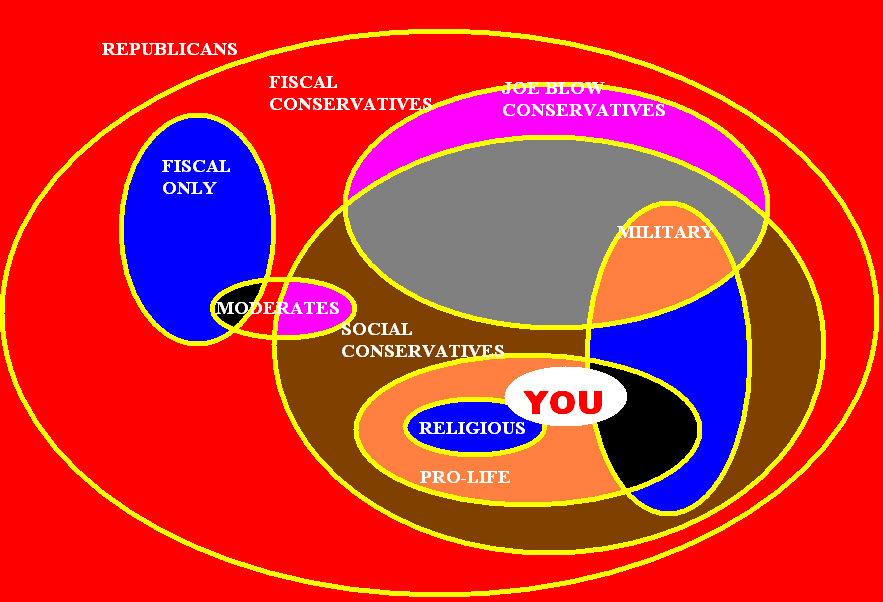
According to the REGION MAP, you are 87% in concurance with PRO LIFE AND RELIGIOUS CONSERVATIES
FACTIONS YOU SHARE NO COMMONALITY WITH:
Fiscal only conservatives
Pro-choicers
FACTIONS YOU SHARE SOME COMMONALITY WITH:
Social conservatives
Pro-lifers
A more complex map can also get into variables and overlapping regions and may go on even more about comparing and contrasting with other political factions.
For example, take this timeline of 100 years:
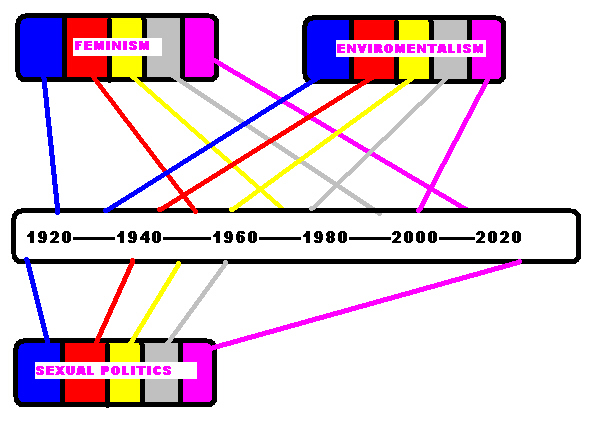
This is a crude pictorial of how different factions of certain movements or subjects grow and change. This can be a graphical way to select information under a certain decade or specific date.
Let's take feminism for example here:
This can be the Theta Q format's version of generic feminism:
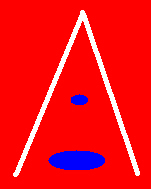 |
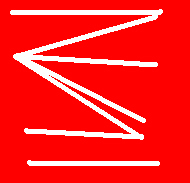 |
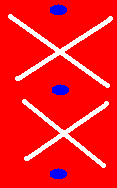 |
 |
 |
 |
|
1) Complaints against sexism
2)Says some convention issexist |
1) Asserts new sex roles
2) Asserts more and more convention is flawed 3) Digs deeper for real roots |
1) Allies with other alienated
sub-cultures
2) Questions all convention 3) Finds new modern manifestations of sexism |
Here a large movement can be broken down into three major components. This is saying that there is an initial premise, and from that are consequences, and from those consequences, long term eventualities happen. These are all subsets and components that are building blocks to a movement. And from analyzing these components and factors, we can determine properties of the movement, like properties of elements and chemicals.
There can be (taking generic feminism as an example):
Common and subfrequent complaints of feminists
Common complaints AGAINST feminists
Common premises of feminists
The antithesis to feminism
Examples and manifestations of feminism
Predictions of feminism
Subsets of feminist ideology and/or feminist factions
Under this analyzation, it can be possible to configure a larger object such as feminism by tweaking the smaller objects of which it is composed. This is like the alienation/Gephardt example above and is the basis for the lopsided heirarchy pictured below.
THE TUTORIAL(PHASE THREE:SEARCH BY TERM RELEVANCE AND RELATED THEME)
Once you click on a map that you like or seems to use language or diction that you understand or feel comfortable with, you can begin to search for a topic that you are trying to find out about. Let's say you are researching condoms in high schools. You type in the word "condoms" (or select it from a generic topic menu) and you get a menu that says:
5% of the 514,569,873 articles are relevance level 1 associated with "condoms"
6% of the 514,569,873 articles are relevance level 2 associated with "condoms"
12% of the 514,569,873 articles are relevance level 3 associated with "condoms"
14% of the 514,569,873 articles are relevance level 4 associated with "condoms"
8% of the 514,569,873 articles are relevance level 5 associated with "condoms"
...and so on.
You would click on level 1 assuming that this would be direct enough for you (and perhaps going through subsequent levels in the future if you do not find what you want) and get a list of themes or formats that have been tagged by previous readers.
Since themes are just long worded tags that the formats use, you may click on the themes first, to see which sub-doctrine you agree with and then later see which formats use many themes that you agree with, to search by using a format.
So, you click on level 1 and hit submit.
You are now browsing a specified subset of the database! You click on browse by theme and see the list. The list may be 500 million items long but the more relevant ones may be brought up to you first judging by the results of your calibration questionnaire that you took at the beginning. You would see a list like this:
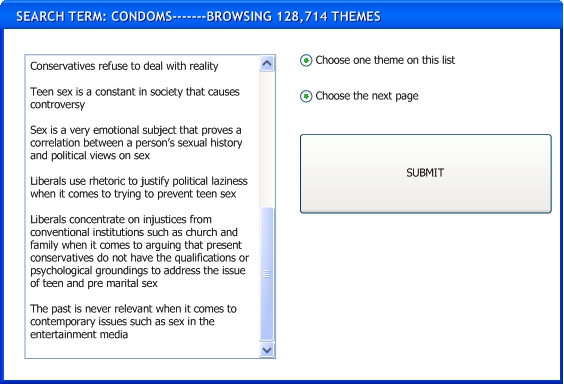
So here you have the first ten of 128,714 themes that users have tagged as first level associated with condoms. You click on the second theme "Teen sex is a constant in society that causes controversy" and see the results, which may be 1,578 articles.
You get the article list and decide which one captivates you the most.
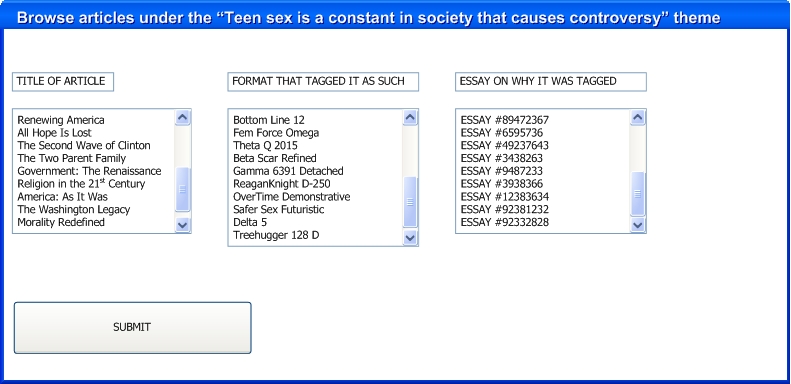
You can read the article or look at the head page to the format that tagged it under that title or read an essay as to why that author of the format tagged it as such.
Here (in the following picture) you can assign a predetermined tag to
an article. These tags would be sentences (or sentence fragments) that
have been written by previous readers. You can assign multiple tags to
one article, OR you can assign multiple articles to one tag.
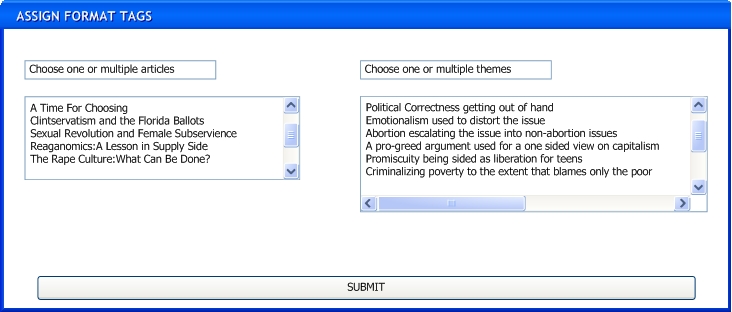
This second scenario depicts assigning tags according to how you
see another persons format. Here you are saying "I believe that the
BOTTOM LINE format author would say that this article reflects the theme
of PC GETTING OUT OF HAND at a relevance of 58%" and then you would tag
it accordingly.
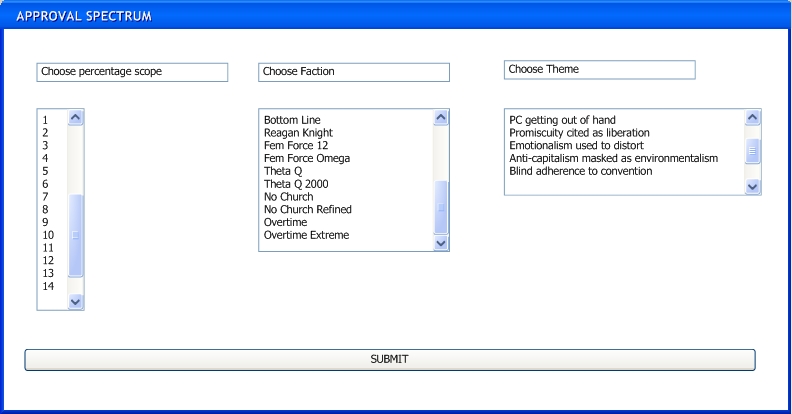
Here is a simple preference depiction. You can browse articles
by using a tag or tags as a compass or you can use one article as a
criteria to find multiple tags.
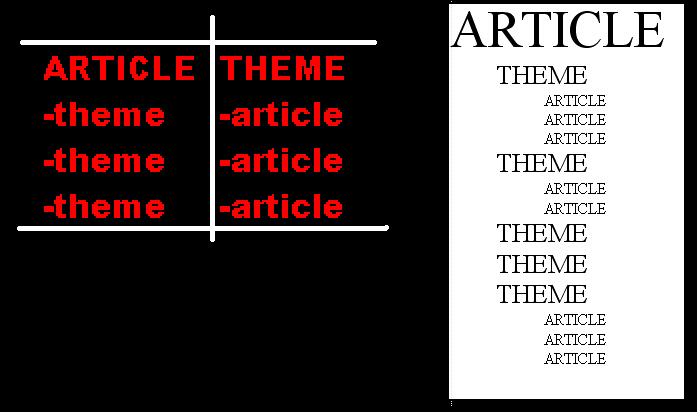
THE TUTORIAL(PHASE FOUR:MAKING YOUR OWN TAGS AND FORMATS THROUGH FURTHER CALIBRATION)
If you would like to create your own format you can simply sign up for the service like geocities or myspace and have a default URL like http://www.hypermaster.com/kelvin912 and log in to it in the future and go through a menu when you read, like DIGG.com uses to tag an article. When you read an article, at the bottom of the article would be an option to tag it, so you click on it.
You can create your own tag right then and there or tag it with a previously made tag from another user (this would be concurring). Now when users browse your format homepage, they can see which articles you tagged and how you tagged them. Your format may very well turn into a semi-search engine for other users.
Okay, here I go. I've covered what I hope my readers will see as a general introduction to my hypermedia software. Here is where I give an attempt at a cut and paste tutorial on how the user can tweak these type of databases to their specific needs:
Level five: (pro or con) I am for (issue1) but can not express it further
Level four: (facet and/or premise for the belief) I am for (issue1) because I believe in (premise1)
Level three: (multiple facets) I am for (issue1) because I believe in (premise1) and (premise2) and (premise3)
Level two: (criss cross references) I am for (issue1) because I believe in (premise1) and (premise2) and (premise3) and am for (related issue1) and (related issue2) and (related issue3)
Level one: (examples and manifestations of the issue) I am for (issue1) because I believe in (premise1) and (premise2) and (premise3) and am for (related issue1) and (related issue2) and (related issue3) because it results in and leads to (example1) and (example2)
So, according to your format, you tag objects with a number from 5 to 1 to create a statistical base for reflecting your perception of politics. The beauty about this is the lopsided hierarchy (that I mention later in this document) is that you can have rated objects behind rated objects and even make loops where the premise may lead to a conclusion that is used for a premise to your original premise! This is a kind of "loop" if you will. I say this to reflect reality because in socio-political concepts, there is a common question as to where a problem actually starts, and backtracking usually puts you in a loop because you get into a question of "which came first-- the chicken or the egg?"
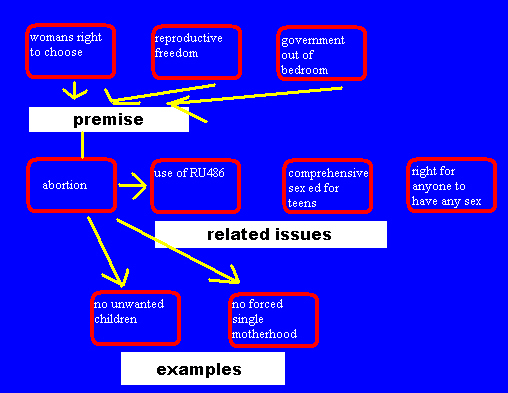
According to politicians (actual people)
In my now extinct No Gore 2000 page, I had the "gore-o-meter" which used Al Gore as the basis for ideological planks. Gore is pro-choice, so being pro-life would be a "2" on his scale. Gore said in a speech that this nation can not afford to keep sentimentalizing a family unit that no longer exists. So a conservative for hardcore old fashioned tradition would be rated a "1" on his scale. Abortion on demand would be a "9" or "10" on his scale. Also, the "gore-o-meter" could have facets such as the Treehugger format version of the "gore-o-meter" and the Theta Q version of the "gore-o-meter". This would mean that each person who owns a format develops their own version of it. This is because many different people are going to have a different perception of what kind of politician Al Gore is. There could be conglomerate gore-o-meters, which would mean that if over 50% of the group of formats agree on at least 10 criteria of what a "9 notch" Al Gore issue would be, then you can have the Treehugger and Theta Q format conglomerate gore-o-meter.
Using multiple people
You can also build a scale that uses politicians as the notches. Gephardt can be a "9" on the democrat scale, and McGovern can be an "8" on that scale. Of course, their would be many issues behind these politicians to make the scale mean something, but you could probably navigate through concepts faster if you use people as an encompassing object to manipulate.
Generic meters
There can also be a generic meter for liberals or conservatives. The Bottom Line format could define a liberal "meter" notch 10 as "100% income tax" or "allow all proposed government programs". The liberal meter could have subsets like there are in real life, such as kinds of liberals, just as I have done with the formats on the home page of this site. The Treehugger format could have liberal divisions such as feminist, environmentalist, safer sex educator and the like. This would allow formats to depict each other and rate them in their own context.
There are four manifestations to a political argument:
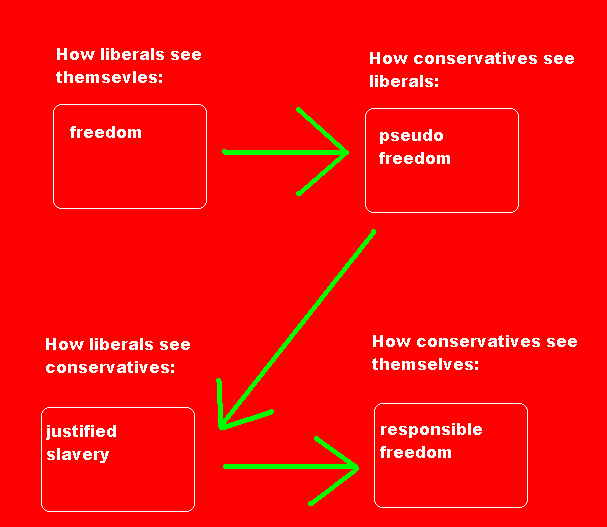
(1)How you see your own side
(2)How you see your opponent's side
(3)How your opponent sees their side
(4)How your opponent sees your side
There are also multi-leveled concepts that can be derived from these, such as how you see how your opponent sees your side of the argument and so on and so on.
All this can be tagged and categorized in lists that confusingly enough are all relative to each other. There is no final denominator. If this system is used to reflect the complexity of issues themselves, then there will be a multi-leveled structure that has thousands of levels that can explain any true underlying premise to an issue to most of the users' content. Few people would keep digging and go in a loop that has ten thousand levels. I use this concept in any issue: let two sides get in a debate and let them go back and forth a couple of dozen times, sooner or later the viewers will see the logic and underlying premise of their beliefs and be sold on a certain side of the issue. Few people will want to dig further than a few dozen or few thousand circles.
TUTORIAL END
FURTHER ELABORATIONS
Furthermore, this can be used to find inconsistencies in your opponents side. If they have an object called "individual rights" with facets such as "sexual activity" and they say that schools have to teach "abstinence only" programs with no mention of condoms, you can say that they have a contradiction because that is legislating "individual rights". So they would have to enter their database and create a separate object for under age children, thus clarifying their argument and causing their database to become more detailed. Do this a couple of thousand times, and you will have a structured logic tree that can be quite impressive.
This is yet another premise that I use for being able to search a political database by theme instead of facts or statements. If 10,000 out of 11,000 people listed as "Rush Limbaugh fans" 80% and above, tag an article as "political correctness getting out of hand" it is possible that you may find exact articles and not have to wade through trash. This puts a burden on the user BUT I feel that if this tool would be used for research by the user for their own benefit, then it would become a passive activity instead of an active activity, thus the finely tuned database would be a by-product of hard work and not some impossible task to compile. Under this, no two people would have to do the same research twice and no two people would have the same argument twice because all of the previous statements would be tagged with countless tags that link to other issue and premises, so they can "sit on the shoulders" of the previous debaters and further the debate.
As I stated earlier the object "political correctness getting out of hand" can be broken down to multiple objects. You can break it into two: "political correctness" and "getting out of hand". Now here is a cool clincher. "Political correctness" is an abstract concept; hardly a single political particle. Therefore it can be made up of many instances or manifestations or examples or components (optional or mandatory).
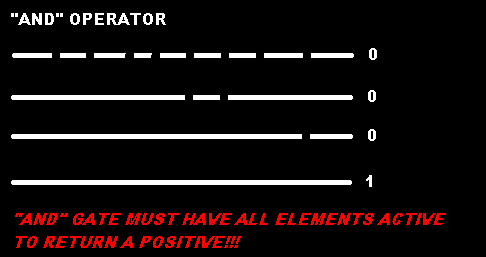
The object "political correctness" of the Theta Q format may be broken down into this:
Anger at past social injustices to certain sub-cultures
Trying to ban personal and non-constructive anger directed at another person for pure malicious reasons
Trying to protect people's feelings
Putting symbolism over substance
Destroying any moral absolutism or authority
This would be a definition: an object made out of other objects.
This would be the "AND" operator in logic. This means that ALL of the
criteria would have to be met to get a value of "YES". This is using
abstract definitions to make yet another abstract concept clearer. This
is like zooming in on a computer picture. No matter how sharp a
picture is with high resolution, it is ultimately made out of ones and
zeroes, which is depicted as colored pixels that are square.
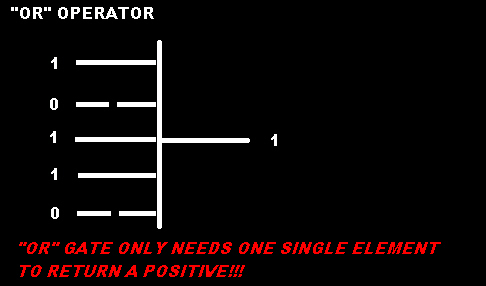
This would have to differ from what makes up the definition. These specifics are EXAMPLES which would mean that they may not reflect the FULL meaning of the term (lose something in the definition process) so these instances would have to be optional meaning the "OR" operator would be used. This means that ANY of the "X number of" items having a value of ONE would return a value of "YES". This is a focusing or fine tuning of understanding the object. This would be using a TOOL to get the abstract picture for the user. The issue here is that not all instances or going to reflect all facets of the larger object trying to be depicted, so each instance is something like an 80% reflection of the object in question.
Christmas decorations being banned in public places
The rebel flag being taken down from state buildings
Making preaching from the pulpit in church against homosexuality a hate crime
Safer sex programs
Racial sensitivity classes being taught and required in schools
You could use a criteria to take SOME of these examples (let's say that you were pulling from a list of ten million) to build the "Bottom Line Kelvin" format definition of "political correctness". This can be reviewed by other readers and added and/or altered to their own format to be used to navigate through articles and used in debates.
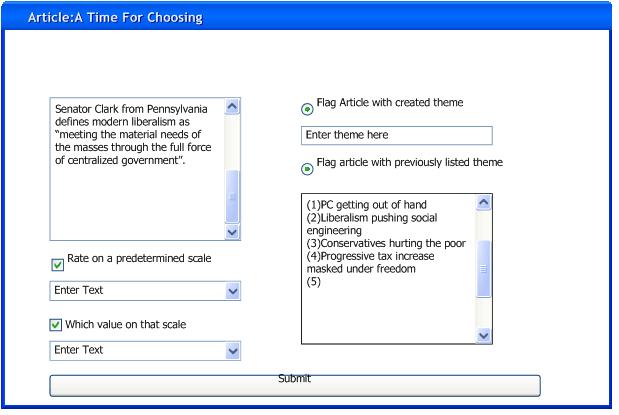
In this example here:
Telling teens to abstain won't work.
Divide the general abstinence object into subsets.
If you blindly tell kids not to have sex, it will have no effect. If you relax or ease sexual morality, it will result in kids having sex. However, giving kids the tools they need to attack pop culture will help them abstain.
and
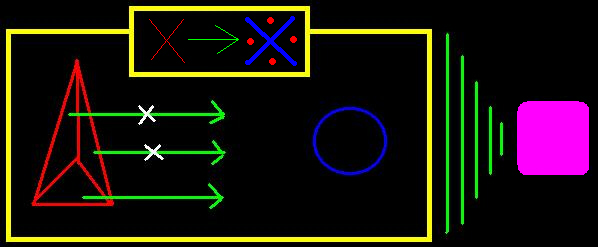
It will take considerable bombardment to counter the programming of pop culture that conditions kids into having pre-marital sex. Only after this will there be a reduction in teen intercourse.
The premise is that each concept has a graphical representation. As you add and add to the argument, more and more implications must be depicted.
As I mentioned earlier, when building a theme, there are actions and objects in the same way there are nouns and verbs in a sentence. When there is an object such as "teen sex" expressed above in the triangle, it has to do something to another object, thus reflecting a theme. According to the format, a yellow "X" can mean abstract version of consequence, and specific subsets to that abstract concept can be elaborated upon:
Here is a choice menu of which direction a user may want to go from CONSEQUENCE.
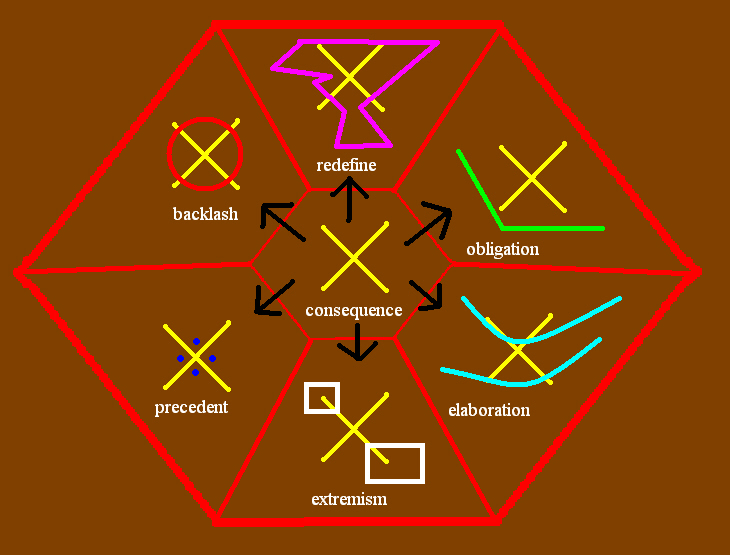
Here a choice is made:

Here is a subset to THAT subset and so on, all defined by an earlier stage of the evolution of the format:
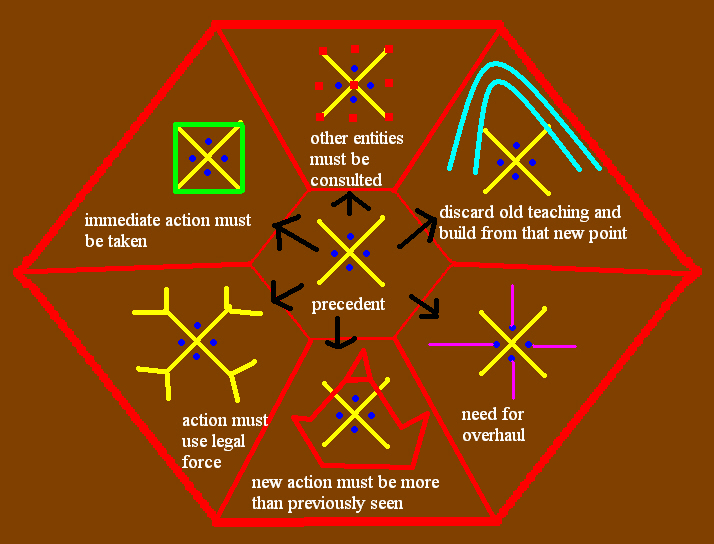
On a scroll menu, there can be choices to construct the parts so a full statement is built:
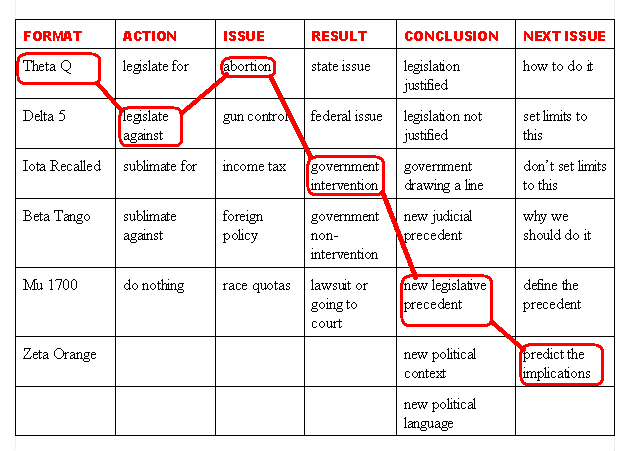
Here, it is done with the icons that represent the objects and actions:
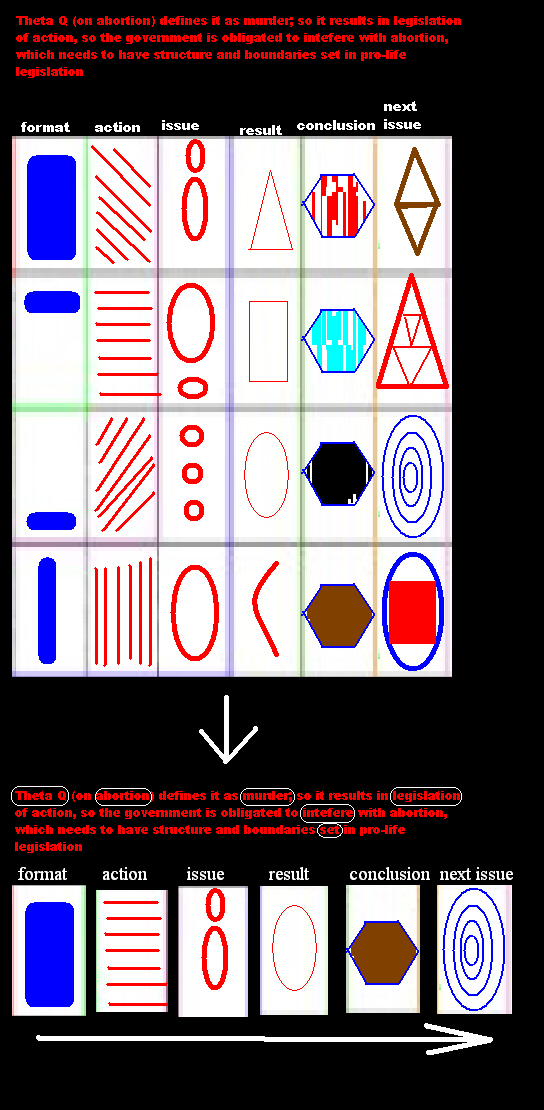
Under OOD Object Oriented Design, variables exist in subsets within each other to represent real life situations. An object called "class" with contain 25 students and each student with have a GPA, first name, last name, SSN, major and gender. In politics however, many people may disagree as to what elements and political themes are subsets or major themes themselves. A main political theme may be tagged as a major theme as well as a subset of a subset of a theme someone else considers a major theme.
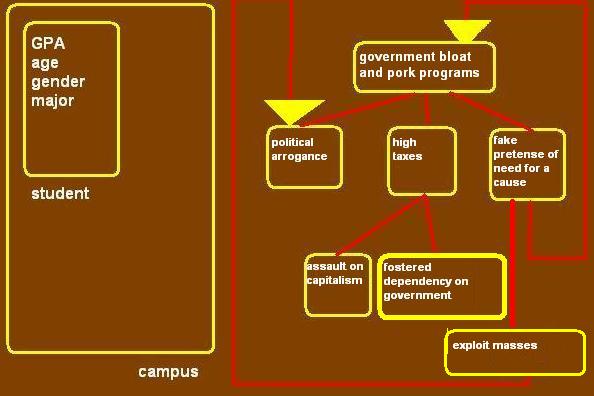
Let's say in a Presidential debate, that one candidate is accusing the other of waffling, or at very least having some form of inconsistency. They can say that a certain law is unconstitutional on certain grounds. This gets very confusing quickly because a debate can quickly go ANYWHERE and in any direction! It is an assertin of mine that if it were done visually that the points that the candidate would be trying to get across would form more solidly in the audience's mind.
For example, on the issue of cutting taxes or having a tax increase, an opponent may have this display on a screen:

As in the aforementioned lopsided OOD, terms can be defined by terms that can be defined by the using of the original term! This is a cause-effect loop. As I mentioned in the first page of this presentation, each term can be defined by a large amount of variables by assigning a "1" or "0" to them. The collective ones and zeroes would make up the definition of that one term, like "taxes". The goal is to never get to an end or base definition; the goal is to go in so many circles with so much elaboration that the concept eventually clicks to the audience! Only THEN will you have a final destination accomplished of getting a core definition to solidify in the midns of the readers/viewers!
There can also be an abstract graphical version of the tree defintion of the word "taxes":
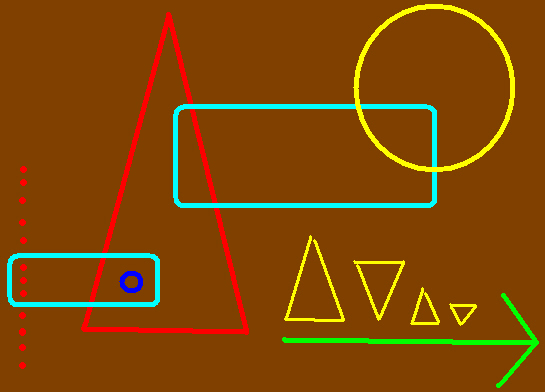
By manipluating the shapes and colors in this pic, you will change the defintion of the word taxes that you use to define in your debates. In a screen like this one, there can be tools on the side just like in MS PAINT where you alter the definition to make it fit your vision of the concept.
To use wording and theme loosely, I believe that there is no such thing as a textbook conservative or textbook liberal once you penetrate the surface of someone's core ideology. There seems to be little pieces of straggling ideology inside all of us that have not cooled or hardened as our surface politics have. In the same way that we are all supposed to have male and female sides regardless of our sex, I believe we all have liberal and conservative sides deep within us. I see it easy to say because I believe what makes a liberal is that a person must see in their formative years that tradition, structure, and convention generally fail in reality. I believe what makes someone a conservative is that they have seen in their formative years that tradition, structure and convention generally work in reality. Now, in all reality, there is some need for dissension and some need for adherence. So I believe what shows a piece of someone's liberal side is when they resist something, and what shows a piece of someone's conservative side is when they adhere to something.
An example of this grid within the grid is an article on www.amazon.com about Eminem, second album, the Marshall Mathers LP. I remember the author being female and seemed to be a feminist as well. She also had problems with Eminem. Now to a typical conservative, they may say that Eminem and feminists are both liberals. After all, neither of them are staunch conservative Republicans. There seems to be a struggle between them. The author of "Boy Clinton" cited a certain kind of liberal as a "Coat and Tie Radical" which is somewhat of an oxymoron. These kinds of liberals are supposed to be conservative on the surface in many ways, such as dress, initial behavior and any other skin deep denominator. His premise was that these liberals were as radical as any tie dye hippie, but were a bit doctored because they felt some need to assimilate into a mainstream culture that was more conservative than them. This author had a streak of that for citing that Eminem was reckless and vulgar. This sounded like a typical conservative clashing with a typical liberal. She then sarcastically stated that he had a lot of oppression to deal with since he was male, white and rich. This sounded like a typical liberal clashing with a conservative. So in two thoughts in the same article from the same person, the "poles" of the ideology differed 180 degrees. The only way to explain this is that this author must have had a conservative subset in her liberal ideology.
In computer software that may reflect this, a certain location can be cited such as coordinates on the XY axis on the political left as (-25, 17), and an entire other origin point be started right there to represent the miniature political grid of liberal and conservative that may exist in someone's clearly liberal stances.
Let's say that on this scale the x axis is traditional liberal vs. conservative. Let's say that the y axis is how loud or offensive you can be about your ideology. A -25 would be saying that rich white males have it easy. A 17 on the y axis would be saying that it is ok to be loud or offensive for your ideology. Now, according to a conservative, the "Coat and Tie Radical" is far to the left, which would be a -25 BUT notice to the liberal that since they are in a suit and may not be the dissenter that conservatives accuse them of being, that they consider themselves conservative in a different context, so in the green line #2, you see the same point that is liberal on the conventional scale, that transfers to a conservative on the new alternate scale that is a subset of the conventional scale. Also, the green line #1 can be the points where a person can be considered vulgar. Note that many conservatives may consider the suited liberal vulgar because they may have a 50% chance of saying any raunchy porn is freedom of speech. So, on one point of the conventional scale may be a 28 BUT to the liberal, they consider themselves composed and ordered (again in the suit, coat and tie) so on THEIR scale they may list themselves as a -20.
In this software, an echoing ellipse can be used to depict implication. Sometimes, on the grid, two shapes might not overlap with each other meaning that they have no common elements. If you can stretch the first object from the left, you may cite that two objects are indeed related once you consider implication of one object.
Let's say that you start with an assumption: Abortion has nothing to do with condoms in high schools.
Extended dimension of abortion related issues.
Abortion is tied to the issue of condoms in high schools.
This graphic can be an example of simply citing objects and their subsets. If you are looking at a big mess, in makes sense that you can find one instance of something, such as "liberalism helping the tax burden for the lower class" and then bring it to the side of the grid window and follow through with all of the subsets of that object.

In the same way that complimentary and supplementary angles exist, so can points being made that compliment and supplement each other. On one of my previous political webpages, I had constructed what I called the Al-Gore-O-Meter. Instead of ranking Al Gore on a scale based on some political denominator, I chose Gore himself to be the denominator and ranked certain articles and terms according to my perception of him. My format is called the Theta Q format, so Al Gore would be the object under my format. This is Al Gore according to the Theta Q format. I started the scale as -10 to 10. I then ranked 10 as ultimately what Gore stands for, and -10 ultimately what Gore is against. Using degrees to label a certain ideological stance, you can make corners, and build polygons with it.

This can be a corner to a triangle. The triangle can be an object under the Theta Q format, and each side of the triangle can be a concept, that is argued to be the main components of the object.
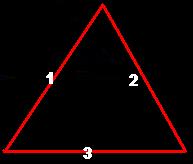
side 1)It is possible for a human being to be angry at things that happened before they were ever born
side 2)Being malcontent, which is more possible in the modern world
where it is harder to be happier because life is more complicated,
pushes a person to search for more societal answers in life
side 3) When subcultures that feel exploited or oppressed are
polarized, it is easier to get more political action out of them, with
far better results
CONCEPT of entire triangle: political correctness, defined as trying to right past wrongs culturally through dissension against convention, flourishes more in the modern world
If you allow angles and polygons to be constructed while trying to combine concepts, you may wind up with something like this:

Each angle can be a number value as to how high a certain concept ranks according to a certain denominator, and can act as a map
Under this system, there are three reactions that you can have to a political object that someone has. You can concur, pervert or water down. Watering down and perverting may seem like versions of each other, so it all boils down to agreeing and disagreeing.
Concur
This is an example where you are taking points and drawing them to their next logical conclusions. This is a form of agreeing.
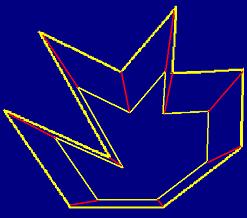
Pervert
This is where you are taking points that the previous person has made and arguing that they lead to something different than the first person has been leading to.
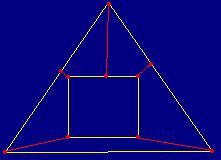
Here is a specific example:
Republicans push and advocate a way of life that never happened
1)pushing structure and tradition is just a mask for blind conformity
2)pushing adherence to family values is just a mask for tolerating domestic abuse
3)pushing tax cuts in the name of economic growth is just a mask for letting the poor starve to death
4)pushing absolute morality when it comes to teen sex is just a mask to excuse parents not discussing sex with their kids
5)pushing a "pro-life" agenda is just a mask to dictate to women as what to do with their bodies
6)pushing religious practice is just a mask to favor conservative Christianity and have it imposed indirectly in schools
7)pushing homosexuality away from kids is just a mask to favor
heterosexuality in a context that places a dirty stigma onto homosexuals
8)pushing against gun control is just a mask to allow violence
9)pushing against so-called government restriction is just a mask to allow big business to reign as an unchecked power
In here you can have these shapes that represent each of the nine objects. The one to the left can be the conservative object, and the one to the right can be the liberal object.
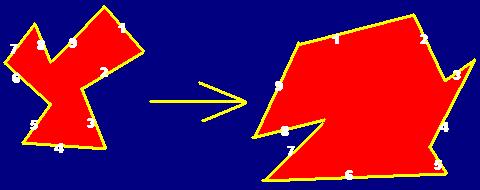
Or in this one where the object is encased in the other
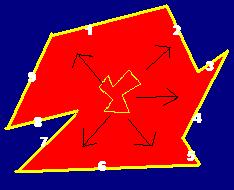
Water Down
This is where there are the most political complaints. This is an example of core ideology being watered down to a more simple ideology. Here the circle can have a value of 360 degrees, or some arbitrary number such as 90. Each of the sides of the internal polygon has a specific issue:
1)alienated subculture
2)sexual issues
3)gender issues
4)political correctness
5)race issues
6)globalism
7)gun control
8)and so on...
The watered down part comes into usually that of a political party where much of an agenda is compromised for some small action being taken in the name of the original causes. One example of this is an entire conservative agenda being traded in for simple tax cuts. Another example is when the AFL-CIO took dues and donated them to Democrat elections in the name of unions, saying that we needed Democrats elected to respect the actions of the AFL-CIO.
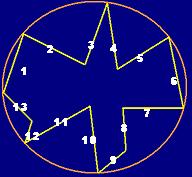
Focusing on the tangible and immediate:
This is where each "side" of a polygon must have a registered object which would be a manifestation of focusing on the tangible and the immediate. As seen in this polygon, each of these sides has another version of itself, in this case, it's manifestation of focusing on the tangible and the immediate. In navigation through information, or in cyber combat (two "formats" fighting each other) a user can click on an object and apply the action focusing on the tangible and the immediate and thus get this resulting shape:

In the same way from about with the triangles representing stages of an argument over teen sex, this too can be an argument taken through the use of an object.
Asserting the most obvious as the most significant:
In a case where a Wiccan says we can fight about who is Catholic or Protestant, but we can not fight over who is human, that we should focus on the fact that we are human more than whether we are Catholic or Protestant.
Note - use diamonds for objects but use rectangles for encasing like above.
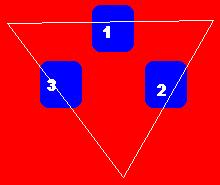
In here, the Kelvin Format may regard a triangle as "political correctness" plainly. As objects are built to make up the things that the Kelvin format considers to be the building blocks of political correctness, the triangle is formed and has the properties thereof. You may zoom in on political correctness and find sexual dissension as being a key element of it according to a certain format, then zoom in on sexual dissension and find political correctness as an element of THAT. This is perfectly consistent because with social issues and politics, it is usually impossible to identify a seed, as opposed to saying that one thing feeds another. Because of this, a "loop" can be established through a lopsided hierarchy (as pictured above earlier in this page) so as to reflect the endless loop of trying to assert where does a social problem truly start.
So, in this virtual environment, you can zoom in or zoom out indefinitely. There are no basic elements such as "1" or "0" such as in an actual programming language. So in cyber combat, two opponents can build an argument by zooming in for an underlying premise or by zooming out to draw an implication of an established premise.
This can be a simple case where a point is made. That point is represented by two triangles that do not include the same space, and a small circle outside of that space. This for example can be a sexist premise, saying that men and women were destined to never truly communicate. The first triangle can be men, the second one can be women and the circle can be communication. To contradict this, you can expand the triangles using the tangible and the immediate object as earlier depicted. The first triangle can have three legs such as:
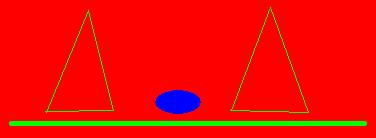
1A)Men and women are different
2A)it's ok to have a "separate but equal" gender standard
3A)There are certain things you shouldn't tell a woman
1B)The same morality applied to the different sexes
2B)Sexism! The sexes are equal BUT different
3B)Use tact when speaking to women but never withhold
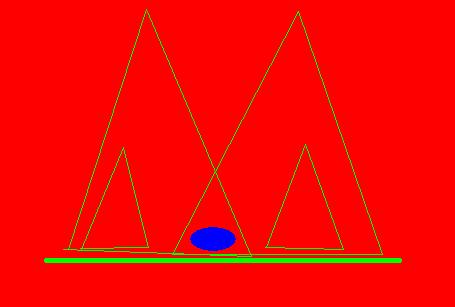
Here are six stages as to how an incident of cyber combat may progress:

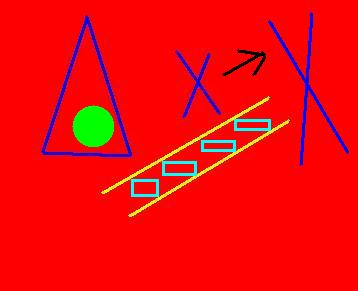
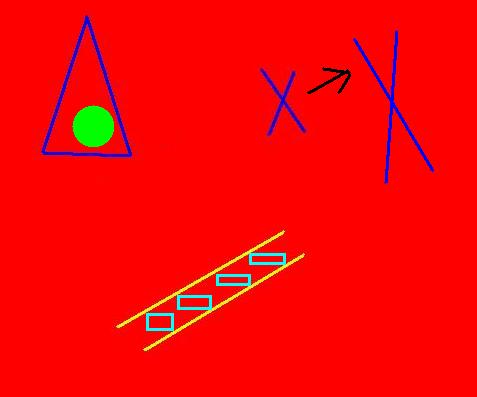
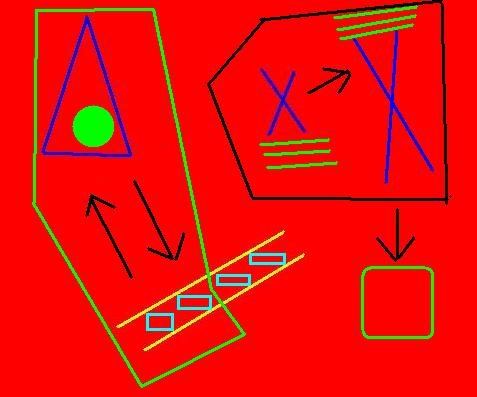
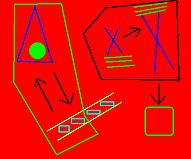
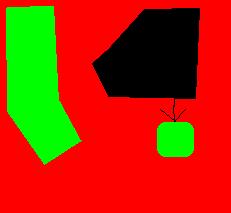
The main direction seemed to progress from zooming out and trying to get key statements/points to turn into building blocks for bigger points.
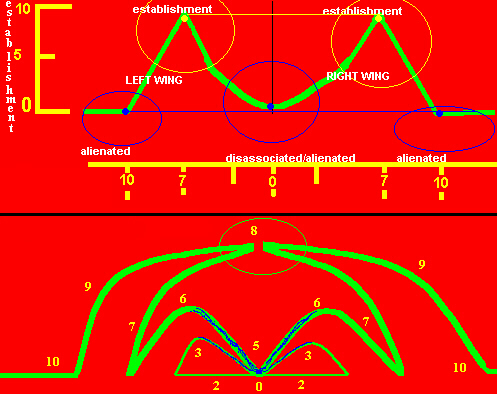
This first picture shows that there is an X and Y axis politically. The X axis is the traditional liberal and conservative. The Y axis is establishment. This asserts that moderates and extremists are alienated against the establishment and do not feel included.
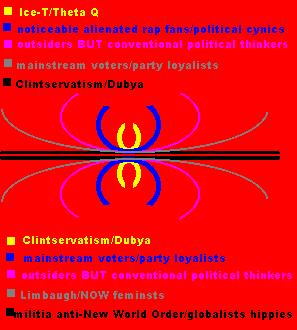
This "spider" picture shows that there can be different factions in politics and depending on your context, extremists of the left and right can gravitate toward each other.
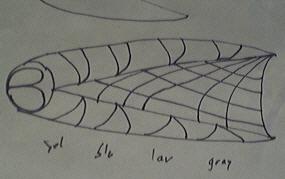
This picture combines the spider picture with a two dimensional Cartesian grid to show that in some cases extremists can actually have things in common, and can sometimes be very different as they appear to be.
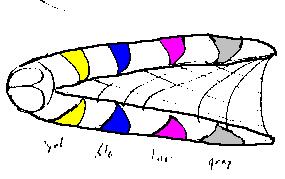
This is with color added to resemble the spider picture.
An area or demographic where people don't usually agree with a certain viewpoint can be listed as the equivalent of a black hole, (density around it that sucks in anything) such as liberals acknowledging that it is possible to attain a 100% pre marital virginity rate.
MISSION:To promote the next level of socio-political activism, mass information handling and the graphical user interface by bringing full control of a 900 trillion article activist database to everyday people by depicting information graphically and organizing material according to theme and concept instead of words.
TO CREATE JOBS by addressing the complexity of the modern world's socio-economic problems by utilizing the computer industry (as part of the information age) to drastically improve the lives of everyday average people.
To create a new form of ideological DEBATE over an information grid to inspire HYPERMEDIA ACTIVISM in "media centers" that are hybrids between town hall meetings and group therapy sessions.
To push the evolution of mass information handling software standards in directions that software CAN go but may not necessarily be headed by default.
To address the inherent need for information to exchange quicker and to be organized more efficiently in the modern world.
To (again) create JOBS by promoting the next generation of mass information handling standards and community activism!
THE SYNOPSIS:
Where can I possibly start? Where can any human being possibly start? Today it is harder to be happier; life is more complex; technology is all around us BUT we seem to have even more problems than a few generations back! It seems that generic hard work is no longer the recipe for happiness or success. The quest now is to find a specific trade or career that utilizes your God given potential. In essence, it is harder to find your niche. Information does not seem to get out fast enough today. We're using fifteenth century convention to handle the information explosion of the 21st century.
To keep in mind when thinking of change:
A STORY OF CHANGE: I was told that with the release of Windows 95, the demand for far more RAM than the typical user had caused users to buy more RAM. Thus, for the first time in computer history, SOFTWARE pushed HARDWARE, as opposed to the other way around. This is an interesting point to make because it demonstrates the potential of elements that can really make waves in the industry. The old standard was to keep in mind the memory and processing power of the machine of the average user and then write the software within those limitations. Microsoft seemed to push the envelope by designing an operating system that demanded significantly more memory that the average user had in their machine. To me, it is obvious that they saw that there was so much demand for the power and features of Windows 95 compared to Windows 3.11 that the user would tolerate having to buy more RAM on the grounds that the new operating system would do all of these demanded things.
WHY CHANGE MAY NOT HAPPEN: Too often, people in the industry act within pre set limits because it is safe. This can be suicide in the computer industry because, at times, there are sharp turns that the industry takes due to technology, demand, and many other circumstances. The formula for survival under these rules seems to be to just bumble along and at the same time do the aggressive research and development to be prepared for those sharp terms. Meanwhile, staying practical, conventional, and focusing on the immediate, pays the bills.
THE LESSON: Here is a case where a computer company had to have enough foresight to see that a gamble (based on perceived demand) would reap rewards. The stakes are higher in these scenarios because meeting the demand is not a simple case that involves guaranteed results. There are obstacles to reaping the rewards of meeting a certain demand. In the aforementioned case, many users could have decided not to buy Windows 95 at all, since they may have not been willing to buy the extra RAM required to run Windows 95. In essence, the innovative movement is UPHILL. Instead of adaptation and innovation being a straight linear shot, the path is a twisted one with dips and perhaps even blockades.
To keep in mind when attempting change in the computer industry:
Conventional 20th century market cornering may seem to have been an art of foreseeing an inevitability, and jumping in front of it to steer it like riding a bull. With the computer industry, one may not be so bold as to say that they know an upcoming change BUT can argue that there is potential for a standard to be adopted under certain circumstances. This may NOT involve an inevitability but involve a mere POSSIBILITY. Certain steps may have to be taken to MAKE the other changes happen in order to make the ORIGINALLY perceived scenario actually happen. This is far more dangerous and riskier than just trying to monopolize on an inevitability. Bill Gates has made a comment on "initiating rather than following trends" in his book "The Road Ahead".
A FEW RANDOM RULES:
Information explosion has resulted in conventional handling methods to address it being inefficient
Information needed to be organized to help people in career orientation, academic research, personal counseling, social activism and other arenas in life
For the most part, hardware forces software standards to conform to hardware limitations.
There are a limitless number of ways to handle the organization of information.
The digital age (and Internet) has made more information readily accessible to us but only opened the door for more complex questions to be asked in the context of how to organize, manipulate and utilize information.
There is a need for a common universal denominator to arise so that information can be exchanged seamlessly over global, technical, industrial and personal boundaries. This is (in essence) everyone being on the same "page".
At certain levels of computer evolution, future levels may not be able to be foreseen until further levels of evolution are attained, or more realistically, the HOW may not be visible until a certain point.
A sharp turn in the industry can be compared to the light bulb; no matter how much you spruce up a candle, and make it burn longer and brighter, it is still not a bulb. This requires a leap over a technological chasm.
The computer industry is littered with these chasms. It seems that the need has to be a burning one in order to make the gamble feasible or remotely profitable. One small example of one of these elements is the fact that video games are developed not with current technology in mind, but with future technology in mind so that when they are released, they take full advantage of the state of the art technology, instead of being three years out of date as far as technological specifications are concerned.
It is hard to get everyone to hop on a technological band wagon. The formula that Microsoft used seems to be to get a solid minority appeal (like they did in the business world), then you can be a strong light in the darkness for other sections of the market and with some modifications, and be useful to the other sections as you were with the original section. They started in the business world with computer use, then got into the home market, after being an established force.
Video applications are now pushing a lot to do with computers since video and 3d graphics are the biggest resource "hog" of all the media that a computer can process.
According to a piece done on NPR the big drop in PC sales around the year 2000 was due to people not needing the latest technology because machines got so powerful. Steve Jobs of Apple said that the third level of computer use was video editing. This is a clear example of the start of the bar being raised for higher and more aggressive computer uses.
There seems to be many obstacles involved in evolving to the next level of computer use. The RAW technology is there, BUT to get everyone on the same page takes a lot of micro-evolution if not downright warfare between industry entities. EXAMPLE: Myspace is nothing but an extreme user friendly version of Geocities. The premise is simple: make things menu driven and graphically oriented to make more computer illiterate people use them! This took from about 1996 to about 2006 to evolve.
There is an inverted pyramid format to high and low level functionality of computers. Low level is the ones and zeros being processed at the bare CPU level. High level is the software that is written by people in a computer language that programmer can understand and utilize. Low level web use would be the bare HTML. High level use would be the browser-based surfing or menu oriented building like Myspace. As the level goes higher there are (1) more STEPS to be taken to get to that level (2) more QUESTIONS that need to be resolved for that level to become practical and useable and (3) more complex RULES that exist on that level of technology.
Backward evolution; start with the last step first to get TO the first step. This is a technique of mine that I use in saying that it is necessary for visionary purposes to see the LAST step first in order to be oriented correctly!
Backward compatibility a big theme in computers. This is to make old stuff work with new stuff and it is a step closer to getting everyone breathing cohesively and "on the same page"
1980's "home" computers were scattered tribes - an effort to visualize all people on one standard back then would have been overwhelming BUT it eventually happened after people going in their own direction for a certain distance. Because of this, the computer industry AS A WHOLE evolved (as a commonwealth of scattered tribes) and eventually got together under the "Wintel" systems.